Beef Grading Quality Assignment 4 Quizlet
Download PDF | Email for Questions
Beef Quality Grades | Beefiness Yield Grades
Beef Quality Grades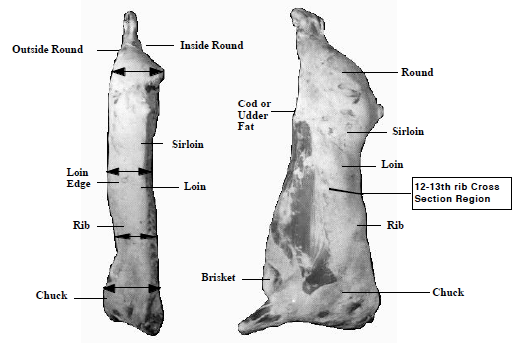
A quality class is a composite evaluation of factors that touch on palatability of meat (tenderness, juiciness, and flavor). These factors include carcass maturity, firmness, texture, and color of lean, and the corporeality and distribution of marbling within the lean. Beef carcass quality grading is based on (1) degree of marbling and (2) degree of maturity.
Marbling
Marbling (intramuscular fat) is the intermingling or dispersion of fat within the lean. Graders evaluate the amount and distribution of marbling in the ribeye musculus at the cutting surface later the carcass has been ribbed between the 12th and 13th ribs. Caste of marbling is the primary determination of quality grade.
Degrees of Marbling
Each caste of marbling is divided into 100 subunits. In general, still, marbling scores are discussed in tenths within each degree of marbling (e.g.,Slight 90, Small 00 , Small x ).
In addition to marbling, there are other ways to evaluate muscle for quality. Compactness of muscle is desirable, as is proper color and texture. Desirable ribeyes will showroom an adequate amount of finely dispersed marbling in a firm, fine textured, bright, ruddy colored lean. As an animal matures, the characteristics of muscle change, and muscle color becomes darker and muscle texture becomes coarser.
Maturity
Maturity refers to the physiological age of the animal rather than the chronological age. Because the chronological historic period is virtually never known, physiological maturity is used; and the indicators are bone characteristics, ossification of cartilage, color and texture of ribeye musculus. Cartilage becomes bone, lean color darkens and texture becomes coarser with increasing age. Cartilage and os maturity receives more than emphasis because lean colour and texture can be affected past other postmortem factors.
Cartilage evaluated in determining beef carcass physiological maturity are those associated with the vertebrae of the backbone, except the cervical (neck). Thus the cartilage between and on the dorsal edges of the individual sacral and lumbar vertebrae also as the cartilage located on the dorsal surface of the spinous processes of the thoracic vertebrae (buttons). Cartilage in all these areas are considered in arriving at the maturity grouping. The buttons are the most prominent, softest and least ossified in the younger carcasses. As maturity proceeds from A to E, progressively more and more than ossification becomes axiomatic. Ribs are quite round and red in A maturity carcasses, whereas E maturity carcasses accept wide and flat ribs. Redness of the ribs gradually decreases with advancing age in C maturity, and they by and large go white in colour considering they no longer manufacture ruddy claret cells and remain white thereafter. Color and texture of the longissimus muscle are used to determine carcass maturity when these characteristics differ sufficiently from normal.
There is a posterior-anterior progression in maturity. Thus, ossification begins in the sacral region and with advancing age proceeds to the lumbar region and and so fifty-fifty after information technology begins in the thoracic region (buttons) of the carcass. Considering of this posterior-anterior progression of ossification, even young A maturity carcasses will take some ossification in the sacral cartilage.
In terms of chronological historic period, the buttons begin to ossify at 30 months of age. Make up one's mind age using thoracic buttons. When the percentage ossification of the cartilage reaches 10, 35, 70, and 90 pct, the maturity is B, C, D, and Eastward respectively.
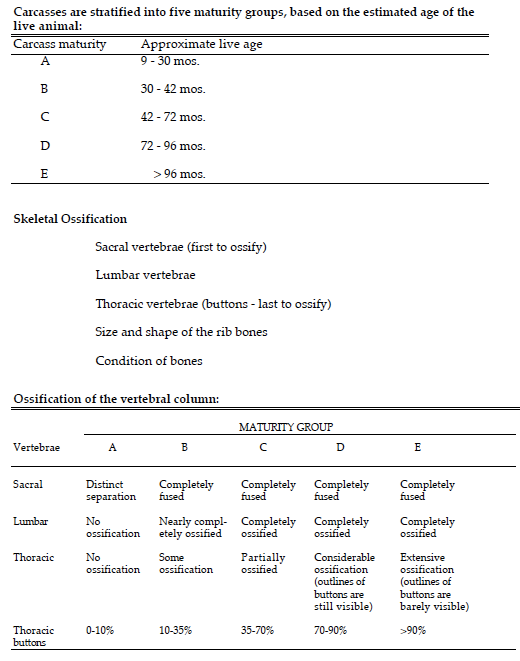
Condition of the bodies of the split chine bones:
A- Blood-red, porous and soft
B- Slightly ruby-red and slightly soft
C- Tinged with red, slightly hard
D- Rather white, moderately hard
Eastward- White, nonporous, extremely hard
Appearance of the ribs:
A- Narrow and oval
B- Slightly wide and slightly flat
C- Slightly wide and moderately flat
D- Moderately wide and flat
Due east- Wide and flat
Lean Maturity:
Color and Texture – Equally maturity increases, lean becomes darker in colour and coarser in texture
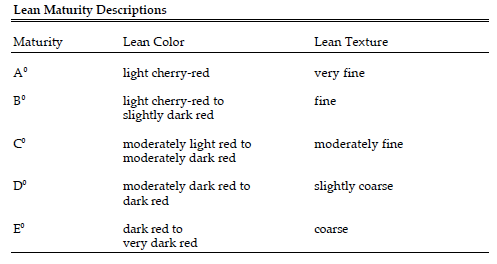
Balancing lean maturity and bone maturity:
1. Utilise a uncomplicated average when bone and lean maturities are within twoscore units of each other.
two. When in that location is more than than xl units difference in lean and bone maturity, average the ii maturities and adjust the average 10% toward the bone except when:
Crossing the B/C line
- If the boilerplate of the lean and os maturities doesn't move across the B/C line from the bone maturity side (e.g., Bone = B and Lean = C with the average being B or Bone = C and Lean = B with the average existence C); boilerplate the two maturities and adjust the average to the nearest 10% toward the bone.
- If the bone and lean maturities are not considerably dissimilar, but i is in B maturity and the other in C maturity and the average of the 2 moves across the B/C line from the os maturity side, the overall maturity will be on the side of bone maturity — it will be either B-100 or C-00.
- In no case may overall maturity be more than i full maturity group different than os maturity. A80 lean + D20 skeletal = C20 overall.
Conclusion of Final Quality Form:
Subsequently the degree of maturity and marbling has been determined, these two factors are combined to arrive at the Final Quality Grade. The fundamentals involved in applying quality grades are learning the degrees of marbling in order from lowest to highest and minimum marbling degrees for each maturity grouping and understanding the relationship between marbling and maturity in each quality class.


Pace-Wise Procedure for Quality Grading Beefiness Carcasses
1. Determine carcass skeletal maturity by evaluating the degree of skeletal ossification in the superlative three thoracic vertebra (buttons), and the sacral and lumbar vertebra. Also evaluate the colour and shape of the ribs. Make up one's mind lean maturity past evaluating the color and texture of the lean in the ribeye exposed betwixt the 12th and 13th ribs.
Skeletal Maturity + Lean Maturity = Overall Maturity
A60 + A40 = A50 (SimpleAverage)
B60 + A80 = B30 (>xl; 10% to bone)
C60 + B10 = C00 (B/C line)
D60 + B20 = C60 (£ 100% from bone)
2. Evaluate the marbling in the ribeye and determine the marbling score.
Overall Maturity + Marbling Score = USDA Quality Grade
A70 + Sm40 = Ch-
B60 + Md40 = Cho
3. Determine lean firmness to ensure that the minimum degree of firmness specified for each
maturity group is met.
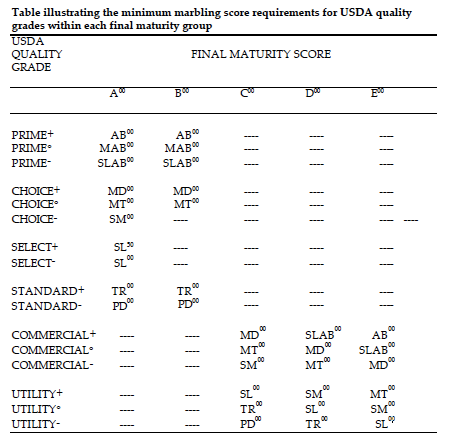
* AB = Abundant; MAB = Moderately Abundant; SLAB = Slightly Arable; Md = Moderate; MT = Modest; SM = Small-scale; SL = Slight; TR = Traces; PD = Practically Devoid.
* Carcasses with B, C, D, or East final maturity scores require an increasing amount of marbling as maturity increases to remain in the same quality grade.
* Carcasses having B concluding maturity scores with Small and Slight marbling must class U.South. Standard. At that place is no U.S. Select grade for B maturity carcasses.
Beef Yield Grades
In beef, yield grades estimate the amount of boneless, closely trimmed retail cuts from the loftier-value parts of the carcass–the circular, loin, rib, and chuck. All the same, they also show differences in the total yield of retail cuts. Nosotros await a YG 1 carcass to have the highest percentage of boneless, closely trimmed retail cuts, or higher cutability, while a YG 5 carcass would have the lowest percentage of boneless, closely trimmed retail cuts, or the everyman cutability. The USDA Yield Grades are rated numerically and are 1, 2, 3, four, and v. Yield Grade 1 denotes the highest yielding carcass and Yield Form 5, the lowest.
The USDA prediction equation for percent boneless, closely trimmed retail cuts (% BCTRC) of beef carcasses is as follows:
% BCTRC = 51.34 Minus five.78 (Fat opposite the ribeye, in.)
Minus 0.46 (Per centum KPH fat)
Minus 0.0093 (Carcass weight, pounds)
Plus 0.74 (Ribeye area, in. 2)
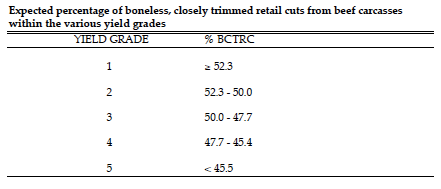 Meat graders assign a yield grade to a carcass by evaluating:
Meat graders assign a yield grade to a carcass by evaluating:
(one) the corporeality of external fat;
(2) the hot carcass weight;
(three) the amount of kidney, pelvic, and center fatty; and
(4) the area of the ribeye muscle.
Graders evaluate the amount of external fat at the 12th rib by measuring the thickness of fatty three-fourths the length of the ribeye from the chine. They adjust this measurement to reflect unusual amounts of fatty in other areas of the carcass. Only graders highly skilled in evaluating cutability of beefiness carcasses make these adjustments according to whether the measured fatty thickness is representative of the fat coverage over the balance of the carcass.
Carcass weight is the "hot" or unchilled weight in pounds (taken on the slaughter-dressing flooring before long after slaughter). The grader usually writes this weight on a tag or stamps information technology on the carcass. The amount of kidney, pelvic, and centre (KPH) fatty is evaluated subjectively and is expressed as a percentage of the carcass weight (this ordinarily will be from two to four per centum of carcass weight). The area of the ribeye is determined by measuring the size (in inches, using a dot-grid) of the ribeye muscle at the 12th rib.
The post-obit descriptions will assistance y'all understand the differences between carcasses from the five yield grades:
Yield Grade 1 – The carcass is covered with a thin layer of external fat over the loin and rib; there are slight deposits of fatty in the flank, cod or udder, kidney, pelvic and centre regions. Commonly, there is a very thin layer of fat over the exterior of the round and over the chuck.
Yield Course 2 – The carcass is almost completely covered with external fat, but lean is very visible through the fatty over the outside of the round, chuck, and cervix. Usually, in that location is a slightly sparse layer of fat over the inside round, loin, and rib, with a slightly thick layer of fat over the rump and sirloin.
Yield Class 3 – The carcass is usually completely covered with external fatty; lean is plainly visible through the fat just on the lower part of the exterior of the circular and neck. Usually, there is a slightly thick layer of fat over the rump and sirloin. Likewise, there are normally slightly larger deposits of fat in the flank, cod or udder, kidney, pelvic and heart regions.
Yield Form 4 – The carcass is normally completely covered with external fat, except that muscle is visible in the shank, outside of the flank and plate regions. Usually, there is a moderately thick layer of external fatty over the inside of the round, loin, and rib, along with a thick layer of fat over the rump and sirloin. There are ordinarily large deposits of fat in the flank, cod or udder, kidney, pelvic and middle regions.
Yield Form five – Mostly, the carcass is covered with a thick layer of fat on all external surfaces. All-encompassing fat is establish in the brisket, cod or udder, kidney, pelvic and middle regions.
Step-Wise Process for Yield Grading Beef Carcasses
 one. Determine the preliminary yield form (PYG).
one. Determine the preliminary yield form (PYG).
Measure out the amount of external fatty reverse the ribeye. This measurement should be made at a point three-fourths of the way upward the length of the ribeye from the split chine bone. Based on this fat thickness, a preliminary yield course (PYG) can be established. The base of operations PYG is 2.00. The more fat reverse the ribeye, the college the numerical value of the PYG.
- A carcass with no fat opposite to ribeye has a PYG of 2.00
- For each .1 inch of fat add together .25 to the PYG
 2. Adjust for carcass weight deviations from 600 pounds.
2. Adjust for carcass weight deviations from 600 pounds.
The base weight in the yield grade equation is 600 pounds. If a carcass weighs more than than 600 pounds, then nosotros increment the PYG, and if a carcass weighs less than 600, then we decrease the PYG.
- For each 25 pounds over 600 pounds, add .10 to the PYG
- For each 25 pounds under 600 pounds, subtract .10 from the PYG
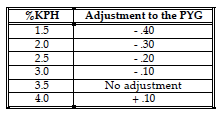 3. Conform for pct KPH deviations from three.5 percent.
3. Conform for pct KPH deviations from three.5 percent.
Information technology has been determined that the average carcass has three.5% KPH. If a carcass has more than iii.5% KPH, then the carcass is fatter than the boilerplate and the PYG should exist adjusted upward, raising the numerical yield grade. If a carcass has less than 3.5% KPH, then the carcass is bacteria than average and the PYG should exist adjusted down, thus lowering the yield grade.
- For each 1%KPH over 3.5%, add .20 to the PYG
- For each 1%KPH under 3.five%, decrease .20 from the PYG
 4. Accommodate for ribeye area (REA) deviations from eleven.0 sq. in.
4. Accommodate for ribeye area (REA) deviations from eleven.0 sq. in.
The average carcass has a ribeye surface area of xi sq. in. If a carcass has a ribeye area greater than 11.0 in., then it is probably more muscular then average, and the PYG should exist adjusted downwards to lower the numerical value of the yield grade. If the ribeye area is less than eleven.0 in., then the carcass is probably less muscular than average and the PYG should be adjusted up.
- For each one.0 sq. in. over 11.0 sq. in., subtract .33 from the PYG
- For each 1.0 sq. in. under 11.0 sq. in., add together .33 to the PYG
Example yield grade problem using the brusque cut method:
Fat thickness: 0.5 in. Carcass weight: 750 lbs. %KPH: two.0 REA: fourteen.0 sq. in.
a. 0.5 in. = iii.25
b. 750 minus 600 = 150 / 25 = half dozen *.1 = .6 (add together)
c. three.v minus ii.0 = i.v * .2 = .xxx (subtract)
d. 14.0 minus 11.0 = 3 * .33 = .99 (subtract)
3.25 PYG
plus .60 Weight
minus .30 KPH
minus .99 REA
two.56 Final YG
Return to Top
Source: https://beefskillathon.tamu.edu/beef-quality-and-yield-grading-2/
0 Response to "Beef Grading Quality Assignment 4 Quizlet"
Post a Comment